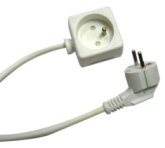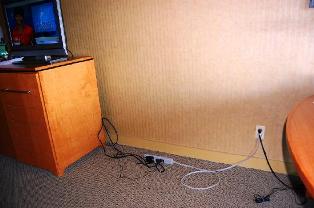Categories: Sharing experience, Electrician Secrets
Number of views: 44301
Comments on the article: 6
How insidious extensions and carrying do not allow power tools to work
 Surprisingly, a fact. Yesterday, a good friend of mine, a homemade friend of mine, called me to see why the circular did not start. He says that before she worked perfectly, then a neighbor took her for a while, and now the circular does not start. The peculiarity of the machine was that it installed a two-kilowatt three-phase electric motor, included in a single-phase network according to the "triangle" scheme, with two blocks of capacitors - working and starting.
Surprisingly, a fact. Yesterday, a good friend of mine, a homemade friend of mine, called me to see why the circular did not start. He says that before she worked perfectly, then a neighbor took her for a while, and now the circular does not start. The peculiarity of the machine was that it installed a two-kilowatt three-phase electric motor, included in a single-phase network according to the "triangle" scheme, with two blocks of capacitors - working and starting.
To determine the malfunction, we first measure the resistance of the motor windings. The resistance of the windings is usually tens of ohms. In this case, the resistance very quickly changes from zero to the maximum value. This is affected by the effect of capacitors. While they are charging, the resistance drops to zero. As the capacitors charge, the resistance increases, and when the capacitors are fully charged, their resistance equals infinity, so the ohmmeter shows the resistance of the motor windings.
After making sure that there are no short circuits and leaks to the ground, we connect the voltage. Turn on the power for 1-2 seconds, so as not to burn the windings and wiring, because starting currents of powerful engines are very large. For these seconds, measure the voltage on the motor windings.
In my case, the voltage turned out to be 160, 120 and 108 volts on three windings, respectively. Of course, this voltage is simply not enough for the operation of such a powerful electric motor.
We are looking for where the tension went. There are no leaks on the case (we measured the resistance between the machine case and all the terminals in advance, and made sure that it is equal to infinity). Dirty and burnt contacts, of course, can create resistance, so we measure the voltage after the starting contacts and in front of them. In my case, the voltage turned out to be the same - 160 V. Moreover, before starting the voltage before the contacts is 230 V, and during starting it drops to 160 V.
It turns out that when we turn on the machine, we "drop" the voltage throughout the house. This is very dangerous for household appliances. We go into the house and measure the voltage in the socket before and during the start of the machine. We get respectively 230 and 210 V. Sagging, of course, is, but not critical. For household appliances - safe. So where did the 50 volts needed to start the machine go?
 And they were lost in the extension cord. The wire used for the extension cord was stranded, thin and very long. Its resistance is 5 ohms.
And they were lost in the extension cord. The wire used for the extension cord was stranded, thin and very long. Its resistance is 5 ohms.
Let's look at how this resistance affects voltage drop. As we remember from the school physics course, the voltage drop during the series connection of consumers is defined as the product of the current in the conductor by its resistance.
When you connect a 100-watt light bulb to the extension cord, the current in the circuit is 100/220 = 0.45 amperes. The voltage drop in the extension cord will be 0.45 * 5 = 2.5 volts. As you can see - this is not scary either for the bulb or for the extension cord.
When connecting a powerful consumer (machine, heater, etc.) with a power of 2000 watts, the current in the circuit is 2000/220 = 9.1 amperes. The voltage drop is 9.1 * 5 = 45.5 volts. Those. we supply 210 volts to the extension cord, and remove only 160.5 volts from it. For an electric motor, this voltage is not enough to work (but enough to burn the windings is enough). But the two-kilowatt heater will give out much less than the calculated power (about 1.1 kilowatts).
BUT! The loss of voltage in the extension cord is not lost without a trace! The extension cord is very hot. Which can lead to melting of the insulation of the wire and internal circuit (or even to a fire of the insulation).
Be CAREFUL and CAREFUL!
Read also on this topic:Why it is dangerous to use tees and extension cords in an apartment
P.S. If you write articles and you have useful and interesting information that you want to place on our site, we will consider and publish it. See article requirements here:https://electro-en.tomathouse.com/article.html

See also at electro-en.tomathouse.com
:
